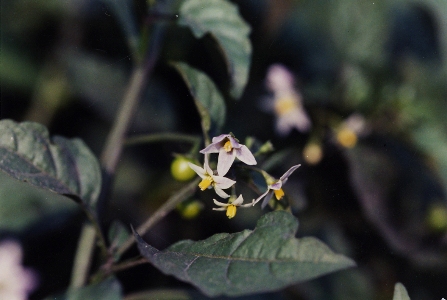7. Solanum nodiflorum Jacq. (syn.: S. americanum Mill. var. nodiflorum (Jacq.) Edmonds, S. americanum var. patulum (L.) Edmonds, S. nigrum var. nodiflorum (Jacq.) A. Gray) (subtrop.) – A rather frequent but poorly understood species, perhaps always ephemeral. Recorded since 1987 from several port areas (especially Gent and Antwerpen but occasionally also in smaller inland ports) but not recognised before 1994 (Verloove & Vandenberghe 1995; sub Solanum americanum). Solanum nodiflorum usually occurs near granaries, unloading quays, under conveyors, in roadverges or on grain dumps.
Solanum nodiflorum belongs to the taxonomically very complicated S. nigrum group. It is most of the times subsumed under Solanum americanum (see synonymy above) or even considered to be conspecific with the latter (see however Henderson 1974, Morton 1976, Heiser & al. 1979). Recent molecular research proved that both are distinct species, Solanum nodiflorum being the most widespread and weedy (Manoko & al. 2007). Both species can be differentiated on a combination of floral and fruit characters. Belgian plants are rather uniform in being glabrescent (only young parts sparsely hairy) and by the absence of exserted styles (clearly exserted in Solanum americanum s.str.). However, Edmonds (2012) suggests that these data are probably unreliable and merges S. americanum and S. nodiflorum, the former binomial then having priority. See also Särkinen & al. (2018).
Solanum nodiflorum is possibly overlooked in Belgium. It much resembles native Solanum nigrum but is, with some experience, readily separated. Inflorescences are always (sub-) umbellate (versus racemose), all floral parts are smaller (corolla, anthers) and corolla lobes are quite often suffused with purple. It should be looked for on agricultural land (maize fields,…).
Many additional, very closely related species have been described in the New World (some with weedy tendencies) but most are probably better included in Solanum nodiflorum, S. americanum s.str., S. ptychanthum and perhaps even S. nigrum. The present treatment is based on Nee’s recent overview (Nee 1999). European records of Solanum americanum, S. adventitium Polgár,… possibly also belong here.

Selected literature:
Edmonds J.M. (2012) Solanaceae. In: Beentje H.J. (ed.), Flora of tropical East Africa. Kew: Royal Botanic Gardens: 1-240.
Heiser C.B., Burton D.L. & Schilling E.E. (1979) Biosystematic and taxometric studies of the Solanum nigrum complex in eastern North America. In: Hawkes J.G., Lester R.N. & Skelding A.D. (eds.), The biology and taxonomy of the Solanaceae. Academic Press, London: 513-527.
Henderson R.J.F. (1974) Solanum nigrum L. (Solanaceae) and related species in Australia. Contrib. Queensl. Herb. 16: 1-78.
Manoko M.L.K., van den Berg R.G., Feron R.M.C., van der Weerden G.M. & Mariani C. (2007) AFLP markers support separation of Solanum nodiflorum from Solanum americanum sensu stricto (Solanaceae). Pl. Syst. Evol. 267: 1-11. [available online at: http://edepot.wur.nl/44477]
Morton C.V. (1976) Revision of the Argentine species of Solanum. Academia Nacional de Ciencias, Córdoba: 260 p.
Nee M. (1999) Synopsis of Solanum in the New World. In: Nee M. & al. (eds.), Solanaceae IV: Advances in Biology and Utilization. Royal Botanic Gardens, Kew: 285-333.
Särkinen T., Poczai P., Barboza G.E., van der Weerden G.M., Baden M. & Knapp S. (2018) A revision of the Old World Black Nightshades (Morelloid clade of Solanum L., Solanaceae). PhytoKeys 106: 1–223. [available online at: https://doi.org/10.3897/phytokeys.106.21991]
Verloove F. & Vandenberghe C. (1995) Nieuwe en interessante voederadventieven voor de Belgische en Noordfranse flora, hoofdzakelijk in 1994. Dumortiera 61-62: 23-45.

